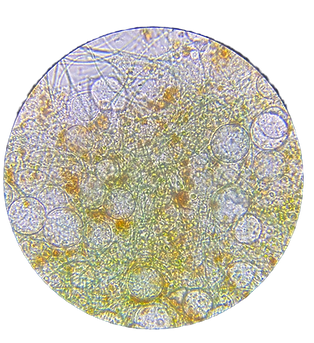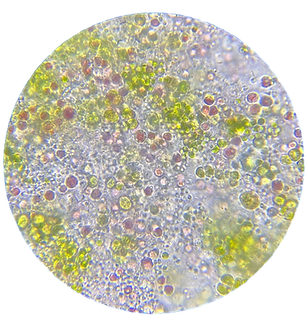Microalgae: Life that transforms the planet
A 3.5 billion year journey into the past
More than 3.5 billion years ago, the first photosynthetic organisms emerged : primitive cyanobacteria and microalgae. These tiny aquatic life forms began capturing carbon dioxide (CO₂) and releasing oxygen (O₂) , triggering one of the most significant events in the planet's history: the Great Oxidation Event (GOE).
Without this biological process, Earth's atmosphere would not have allowed the evolution of multicellular organisms or life as we know it today. Microalgae are the ancestors of all trees, plants, and forests, and they continue to be responsible for at least 50% of the planet's oxygen.
What are microalgae?
Microalgae are unicellular photosynthetic organisms that inhabit aquatic environments, both marine and freshwater.
They use sunlight, carbon dioxide, and inorganic nutrients to grow, producing biomass rich in proteins, lipids, carbohydrates, pigments, and antioxidants. Their molecules have unique properties that make them ideal for various industrial, environmental, and food applications.


Biodiversity
There are an estimated 300,000 species. They are abundant in nature and are found in lakes, rivers, and seas, both in freshwater and saltwater. They can grow in a wide variety of environments, tolerate a wide range of temperatures and extreme conditions, and have been found from the salty Dead Sea to Antarctica.
Do you want to learn about the microalgae we work with at ALIS?


Porphyridium
Chlorella
Type: Red microalgae (unicellular Rhodophyta)
Relevance: A genus that produces sulfated polysaccharides with antiviral, antioxidant, and anti-inflammatory effects. It is rich in phycoerythrin, valuable in the cosmetics industry.
Type: Green microalgae (Chlorophyta)
Relevance: Excellent strain for absorbing CO₂ and water pollutants. It is rich in chlorophyll, antioxidants, and proteins.

Spirulina
Type: Cyanobacteria (also called blue-green microalgae)
Relevance: High protein content (>60%), iron, vitamins and phycocyanin, an antioxidant with nutraceutical value and used as a natural colorant.

Scenedesmus
Type: Freshwater green microalgae
Relevance: Rapid growth, excellent in polluted environments. High efficiency in nitrogen and phosphorus removal.
Microalgae and oxygen generation
“The oceans are a different forest”
It is estimated that marine microorganisms in the oceans, including microalgae, produce 50 to 85% of the total oxygen released into the atmosphere each year.
According to some estimates, microalgae can produce up to 10 times more oxygen per unit area than terrestrial plants, due to their faster growth rate and greater photosynthetic efficiency.
Photosynthetic Efficiency
Why is photosynthesis in microalgae more efficient than in plants?
-
More efficient light absorption: Microalgae have a higher surface area-to-volume ratio than plants, meaning they can absorb more light per unit of biomass. They also have specialized light-harvesting complexes that can capture light more efficiently than plants.
-
More efficient carbon fixation: Microalgae have a unique carbon-concentrating mechanism that allows them to concentrate carbon dioxide around the carbon-fixing enzyme, which improves their photosynthetic efficiency. Plants, on the other hand, have a less efficient carbon-concentrating mechanism.
-
Faster growth rate: Microalgae can grow much faster than plants, meaning they can produce more biomass per unit of time.
-
No need for structural support: Microalgae don't need to invest energy in building and maintaining a complex vascular system, which means they can allocate more energy to photosynthesis. Plants, on the other hand, need to invest a significant amount of energy in building and maintaining their structural support system.
Some studies have even suggested that large-scale microalgae cultivation could help mitigate climate change by sequestering carbon dioxide from the atmosphere and producing oxygen on a large scale.
Microalgae and Wastewater

Biotechnological treatment
Microalgae naturally purify water by absorbing contaminants, reducing costs and chemical use.
Nutrient availability
Wastewater contains nitrogen and phosphorus, essential nutrients for the accelerated growth of microalgae.
Circular
Economy
The waste is converted into valuable biomass that can be used as industrial raw material.
Microalgae and Polluted Air
CO2
Capture
Microalgae absorb carbon dioxide from the air, helping to mitigate urban and industrial emissions.
Oxygen
Generation
They generate pure oxygen through photosynthesis, improving air quality in polluted areas.
Active
Biofiltration
They function as living filters that remove fine particles and toxic compounds from the environment.

Microalgae and Biodiversity

Living
Habitat
Microalgae promote microecosystems that attract insects, birds, and beneficial microorganisms.
Green where there is NO soil
They allow the introduction of life and photosynthesis into dense urban environments without the need for soil.
Nature
and City
They connect people with natural processes, fostering environmental awareness and urban resilience.
Microalgae and Food
High nutritional density
Microalgae offer protein, antioxidants, omega-3s, and vitamins in higher concentrations than many conventional foods.
Sustainable production
They require little land and water, generating fewer emissions than traditional protein sources.
Versatile applications
They are integrated into supplements, functional foods, colorants and natural additives.

Microalgae and Cosmetics

Bioactive ingredients
Microalgae contain antioxidants, polysaccharides and pigments that nourish, regenerate and protect the skin.
Natural and Sustainable origin
They are a clean and renewable alternative to synthetic or animal-based compounds.
Proven Effectiveness
They improve hydration, elasticity and luminosity, making them ideal for anti-aging and functional cosmetics.
Microalgae in summary:
Microalgae have great potential and a promising future for several reasons, including:
High Nutritional Value: Microalgae are rich in essential nutrients such as proteins, omega-3 fatty acids, vitamins, minerals, and antioxidants. They also have a balanced amino acid profile, making them a nutritious and complete food source.
Health Benefits: Microalgae have been linked to numerous health benefits, including improved cardiovascular health, enhanced immune function, and potential anticancer properties, thanks to their high nutritional content and bioactive compounds.
Sustainable and Environmentally Friendly: Microalgae can be cultivated sustainably using minimal land, water, and resources compared to traditional agriculture. They have high photosynthetic efficiency and fast growth rates, making them a potentially sustainable food source without putting additional pressure on the environment or competing with traditional agriculture for resources.
Food Security: As the global population continues to grow, microalgae could be a valuable and sustainable food source to address food security challenges, especially in regions where traditional agriculture faces limitations due to resource scarcity or climate constraints.
Climate Change Mitigation: Microalgae can capture and sequester carbon dioxide (CO₂) during growth, making them a potential tool for mitigating climate change by reducing greenhouse gas emissions. They can also be used in wastewater treatment to remove pollutants and nutrients, contributing to clean water access and environmental sustainability.
Versatile Applications: Microalgae can be used in a variety of food products, including plant-based protein alternatives, functional foods, and dietary supplements. They also play a key role in the development of next-generation functional cosmetic products, as they can be processed into powders, oils, and extracts, allowing for versatile applications and the creation of high-value products.

